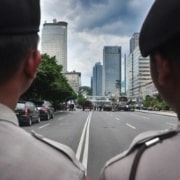
The first McDonald’s restaurant in Indonesia opened at Sarinah in 1991. Photo by Aprillio Akbar for Antara.
A crowd formed outside the Sarinah department store in Jakarta earlier this month, in breach of the capital’s social distancing directives, to bid farewell to a popular local hangout spot. Online, a sepia-toned sketch of the venue was widely shared, with the words: “Thank you for the moments of togetherness that won’t be forgotten”.
The landmark causing all the commotion wasn’t a heritage cinema, an independent music venue, or a public park – it was a McDonald’s restaurant.
There are more than 200 McDonald’s operating across Indonesia, with dozens of them located in Jakarta. Besides the influence of an extremely well-run public relations campaign — which was almost certainly a factor, and for the company probably worth the Rp 10 million fine it incurred for violating Covid-19 restrictions — why did the closure of this McDonald’s cause such a stir?
The Sarinah outlet’s status as the longest-running McDonald’s in Indonesia (with a brief blip in its history when it was rebranded as the pirate-themed Toni Jack’s during a licensing tussle) is a dubious trigger for sentiment on its own. But a look at the history and pattern of urban development in Jakarta helps explain the bizarrely emotional public response.
Jakarta is a rapidly urbanising megacity with very little public space. As of 2017, less than 5% of its area was taken up by green space – far below the 30% target (20% public and 10% private) outlined in the city’s medium-term development plan. Between the city’s expanding private developments and its dense private-public urban kampungs, there is scant shared space for citizens to negotiate a ‘sense of place’. This is a process urban theorists call placemaking and it can support other aspects of a city’s social, cultural, and environmental well-being.
One significant area where Jakarta’s sense of place is regularly negotiated is the Thamrin-Sudirman thoroughfare. Constructed in the 1950s as the capital’s main drag, its development has reflected the tensions of developing Indonesia. As noted by Twitter users, the section of the road overlooked by the Sarinah McDonald’s has also borne witness to several major events in Jakarta’s history, including last year’s deadly post-election riots and a terror attack in 2016.
The Sarinah building itself holds historical value as a relic of Soekarno’s grand vision for the capital. Soekarno’s Jakarta was a city of imposing monuments, wide boulevards, and modernist glamour. The Sarinah department store opened in 1962 and was named after Soekarno’s nanny. It was simultaneously a socialist tool intended to act as a price stabiliser, following examples in the communist world, and a capitalist marvel – the first of its kind in Indonesia to boast escalators, air conditioning, and electronic cash registers. The building is still the property of a state-owned enterprise.
Under Soeharto, both Jakarta and Sarinah changed. Modernisation and nation-building were still major drivers of urban development, but the doors were flung open to foreign capital. While Sarinah remained in state hands, parts of the building were leased to American franchises like Hard Rock Cafe and McDonald’s, which arrived in 1991.
With a growing middle class came a growing culture of conspicuous consumption. The memories shared on social media this month show that in the early 1990s, a trip to the newly opened McDonald’s was a photo-worthy family event. This was not just because of the expense (far more than a meal at a standard food stall), but also the novelty and the status of participating in a global lifestyle.
Memories of excitement over a meal at McDonald’s now carry a sense of nostalgia for middle-class Jakartans. Meanwhile, the once impressive Sarinah building is now dwarfed by a thicket of skyscrapers. It is an unremarkable stop in a strip of luxury hotels and shopping malls. Its dripping ACs and creaking narrow escalators hold little appeal for today’s shoppers – it’s no surprise that management has plans to renovate the entire building, not just the McDonald’s, as part of a larger plan to return to Soekarno’s vision for the store as a champion for local creative industries.
Cultural studies critiques of the 1990s and early 2000s often use the McDonald’s brand as shorthand for globalisation and anxieties surrounding the loss of local culture. These narratives tend to take on a disparaging or even condescending tone when describing Asians consuming symbols of Western lifestyles. Solvay Gerke, for example, wrote of Indonesian families “spending hours sitting in strategic places, where they could be seen by all and sundry” with their McDonald’s meals, later taking the empty takeaway bags with them “so that everybody in the street could see where they had lunch or dinner”.
There is an assumption that the process is passive, that the symbol is swallowed whole. But in fact, active negotiations of meaning still occur – the unspoken use of the Sarinah McDonald’s as a meeting point for the LGBT community is a case in point. In this light, it could be argued that Jakartans have indeed managed to negotiate a ‘sense of place’ in a 29-year-old fast-food outlet.
But without access to true public space, several parts of the placemaking puzzle are still missing.
For urban theorists, the dominance of privatised space in a city like Jakarta raises concerns over citizens becoming consumers rather than producers of public space, with detrimental effects for society, culture and the environment. It eliminates participation by citizens in decisions about spatial planning, diminishes the socially equalising influence of public interaction between classes, and hides from view the impact of consumption on the natural environment.
Since 1998, the pattern of urban development established under the first two presidents has changed. Where development processes were unquestionably top-down under Soekarno and Soeharto, now the actors of urban change are harder to identify, as they work through complex, decentralised, and often corrupt systems.
More egalitarian and democratic uses of space on the Thamrin-Sudirman thoroughfare, like the car-free day held once a week, or demonstrations on the Hotel Indonesia roundabout, still provide only limited scope for citizens to determine the function and identity of their city.
This lack of options explains why public life for middle-class Jakarta continues to largely take place in privatised space, like the city’s 170-plus shopping malls. Tenuous attachments to place can be formed in these artificial spaces, but can just as easily be broken – and often are, without consultation.
The mourning of a fast food giant might appear a bit pathetic at first glance. But in the context of Jakarta’s urban development, the spectacle at the Sarinah McDonald’s may reflect a deeper sense of loss felt by citizens over the chance to negotiate meaning and identity in the places that matter to them. Ultimately, perhaps it is really this loss of sense of place that they are mourning, and not just the passing of another McDonald’s branch.










